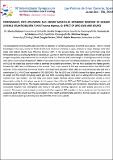Por favor, use este identificador para citar o enlazar a este item:
http://hdl.handle.net/10261/313882COMPARTIR / EXPORTAR:
 SHARE
BASE SHARE
BASE
|
|
| Visualizar otros formatos: MARC | Dublin Core | RDF | ORE | MODS | METS | DIDL | DATACITE | |

| Título: | Performance, feed utilization and hepatic molecular metabolic response of weaned juvenile Atlantic bluefin tuna (Thunnus thynnus, L): effect of lipid level and source |
Autor: | Betancor, M.B.; Ortega-García, Aurelio; de-la-Gándara, Fernando; Sprague, Matthew; Tocher, D.R.; Mourente, Gabriel | Palabras clave: | atún rojo Centro Oceanográfico de Murcia Acuicultura Thunnus thynnus bluefin tuna larval rearing Nutrition Feed utilization formulated diets weaning lipid growing |
Fecha de publicación: | 3-jun-2018 | Citación: | 18 International Symposium on Fish Nutrition and Feeding. (03/06/2018 - 07/06/2018. Las Palmas de Gran Canaria (Spain)). 2018. . En: , . | Resumen: | The development of formulated diets and feeds is essential to increase production of farmed tuna species. There is limited knowledge of this topic, mainly on Pacific Bluefin tuna (Thunnus orientalis) in Japan, whereas no major attempts have been made with Atlantic Bluefin tuna (Thunnus thynnus; ABT). In the present study, two trials were performed using inert formulated diets as on-growing feeds for weaned ABT juvenile in order to establish adequate dietary levels of both lipid and omega-3 long-chain polyunsaturated fatty acids (LC-PUFA). In a first trial, ABT (initial weight = 2.9±0.9g) were fed for 10 days with either a commercial (Magokoro®, MGK) or two experimental feeds with two different lipid levels (15 or 20%) using krill oil (KO) as the single lipid source in order to estimate the suitable lipid content. Fish fed MGK displayed the highest growth, followed by 15KO, with no differences in fish survival. Thus, a lipid content of 15% was considered better than 20% for ABT juveniles. In the second trial, fish (initial weight = 3.3 ± 0.6g) were fed either MGK, 15KO or a feed containing 15% lipid with a combination (1:1, v/v) KO and rapeseed oil (RO) (15KORO). Fish fed 15KO and 15KORO showed the highest growth in terms of weight and fork length (including weight gain and SGR). Increasing dietary lipid level or adding RO to the feeds did not increase liver lipid content. The liver fatty acid profile largely reflected dietary intake confirming very limited LC-PUFA biosynthetic activity for this teleost species. In this respect, liver of fish fed 15KO and 20KO displayed the highest contents of docosahexaenoic acid (DHA). The hepatic expression of genes of lipid and fatty acid metabolism, transcription factors, and antioxidant enzymes was investigated with many of the genes showing regulation by both dietary lipid and LC-PUFA contents. The present study showed promising results that suggested ABT juveniles can be on grown on inert dry feeds that supported good fish growth and the accumulation of the health-promoting fatty acid DHA. Further studies are required in order to fully elucidate lipid and fatty acid requirements of this iconic species regarding dietary sources and production costs. | URI: | http://hdl.handle.net/10261/313882 |
| Aparece en las colecciones: | (IEO) Comunicaciones congresos |
Ficheros en este ítem:
| Fichero | Descripción | Tamaño | Formato | |
|---|---|---|---|---|
| 6211.pdf | RESUMEN | 425,68 kB | Adobe PDF |  Visualizar/Abrir |
CORE Recommender
Este item está licenciado bajo una Licencia Creative Commons

